Lark Rise to Candleford
The Oldest Continuously Inhabited House in the County
Dating back to at least the fourteenth century, Old Manor Farm in the village of Cottisford, Oxfordshire is listed on the National Heritage List for England as a Grade I Listed Building (List Entry Number: 1046440).
Built by Sir Roger de Cotesford in the fourteenth century Old Manor Farm is believed to be the oldest continuously inhabited house in the county, (Read Article)
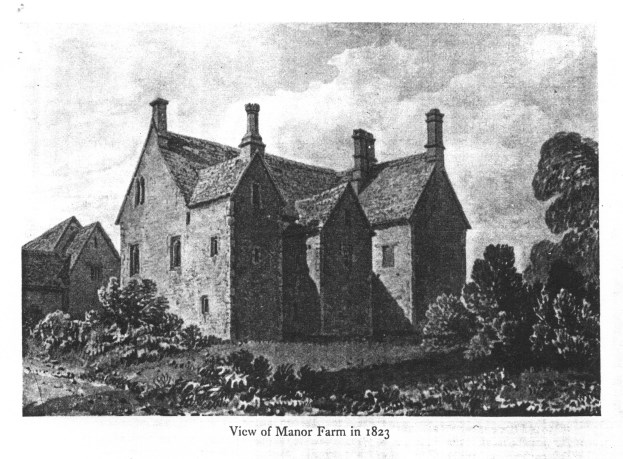
Drawing of The Manor House
The Manor House, Cottisford later became known as Manor Farm and nowadays Old Manor Farm. The drawing below shows the North Wing (to the left) and West Wing (centre of image).
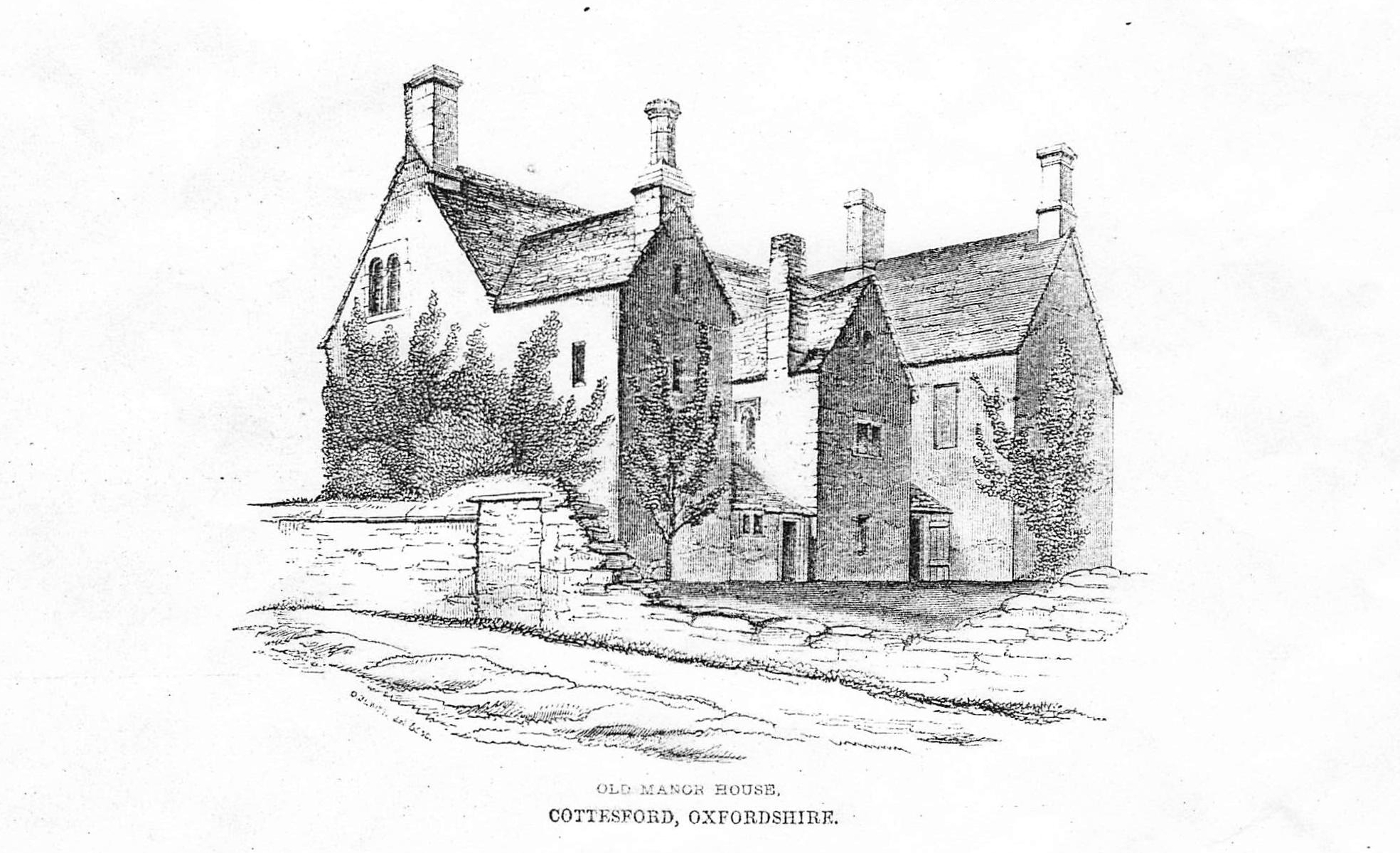
Old Manor Farm – the West Wing
View of the West Wing of the Old Manor Farm
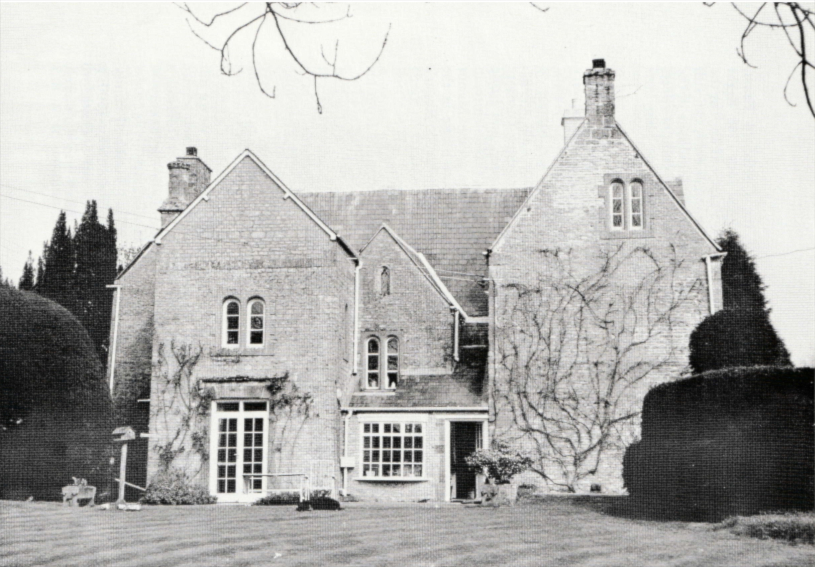
Old Manor Farm – the South Wing
View of the South Wing of the Old Manor Farm
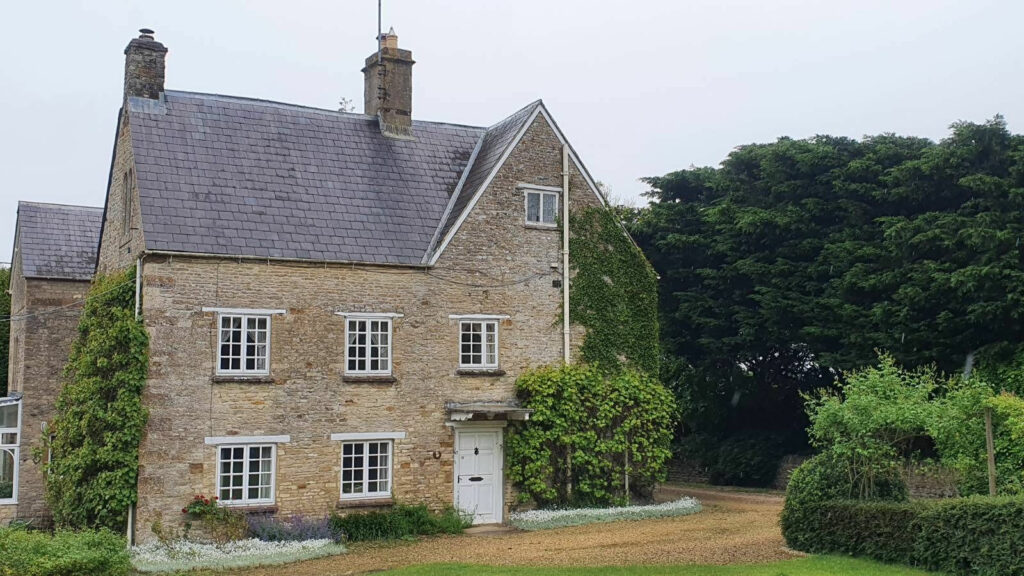
Old Manor Farm, Cottisford
Details below show the South and East Wings
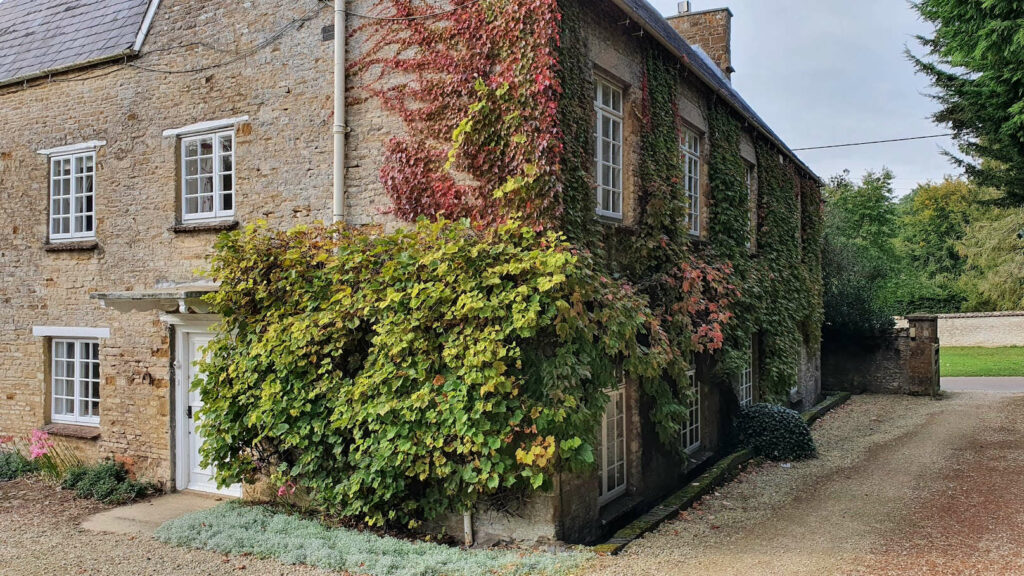
Interior Roof Spaces
The Showing the interior roof space in the attic at Old Manor Farm, with what may be original 13th / 14th Century beams on view – although the roof was rebuilt in the late 16th Century (2)
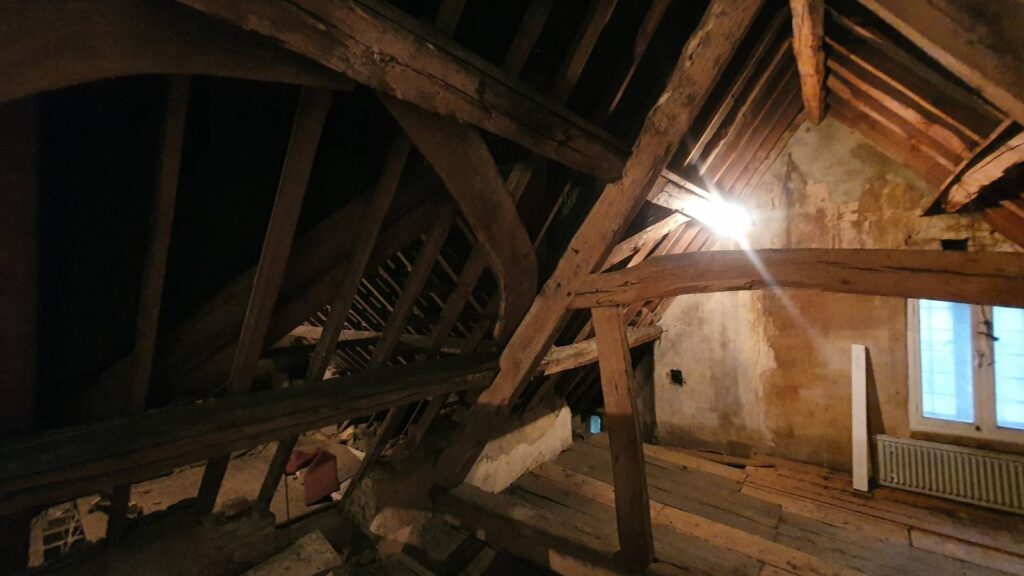
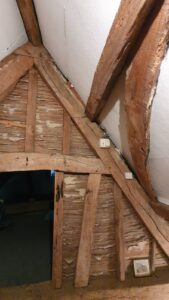
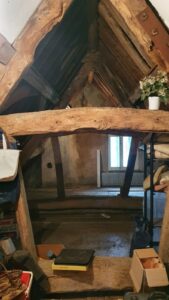
The Garderobe
The Garderobe or the old “privy” (Now in the en-suite washroom to the master bedroom on the first floor)
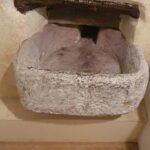
Extract From: Traditional Domestic Architecture In The Banbury Region – Raymond B Wood-Jones 1963 | (Page 24)
The scarcity of medieval houses in the region below manorial rank and the obvious influence of the manor-house on the subsequent development of the yeoman house, calls for consideration of such instances within the region which preserve sufficient evidence of the original arrangements.
Manor Farm, Cottisford, in Oxfordshire (Fig 4 from book – reproduced below) lying beyond the north-east boundary of the Banbury Region, in the area of grey limestone south of Brackley, is of particular interest as representing the manorial plan with the hall at first-floor level.
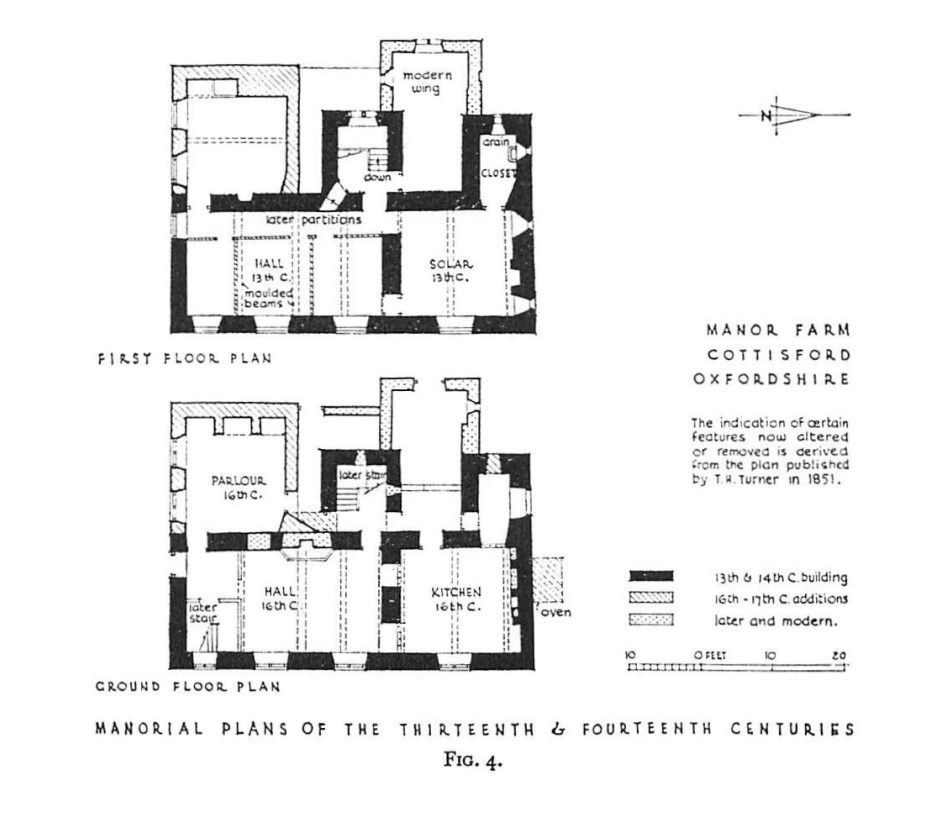
This is an established plan type of the 12th and 13th centuries, a development from ‘Norman’ instances, such as Boothby Pagnell in Lincolnshire, and ultimately related to the stone defensive keeps or donjon towers of the Norman castle.
The building which may have been the former manor-house, dates from the late 13th or early 14th century – the evidence of architectural detail suggest the later date, although there is a window in the north gable dating from c 1200 which has presumably been re-used – and there have been extensive alterations on the 16th century and more recently.
A plan of the house was recorded by Turner and Parker in 1851, and since this date there has been further addition and modernization.
The manor-house, a rectangular structure with stone walls averaging 2 feet 6 inches in thickness, was originally of two storeys, although the existing first floor and its beams are 16th century renewals.
The plan comprises two ‘units’, with the principal rooms formerly on the first floor and open to the roof. These would be the hall and solar, the former measuring 27feet by 25 feet wide. There are, in addition, two small projecting wings on the west wall, the more northerly opening from the solar and measuring 5 feet 6 inches by 9 feet internally, providing a small closet on the first floor.
Within this small apartment is an original stone trough and drain on the north wall, together with two contemporary windows of rectangular form with simply spayed jambs.
The fine 14th-century stack which surmounts this projecting wing, octagonal in plan, with battlemented cresting, does not connect with a fireplace and is presumably a vent to the closet.
The central projection may be of later date, and its purpose is not clear, although oening from the hall it could be a small service room or store.
The principal stair is contained in this projecting, but there is no trace of the original stair, that in the south-east corner being of recent date.
In its original state the ground floor presumably provided storage and service accommodation. It has, however, been extensively altered in the 16th century when the floor was converted to provide the principle living apartments; these subsequent developments are considered in a later chapter. Few of the original details have survived these alterations, apart from two trefoil-headed lancet windows in the north wall of the solar.
References
The following documents in PDF format contain references to different aspects of the historical significance of Old Manor Farm (each link opens in a separate window):
- Cottisford Booklet Pages (01)
- Cottisford Booklet Cover
- Cottisford Booklet Pages (02)
- Cottisford Booklet Pages (03)
- Cottisford Booklet Pages (04)
- Martin Greenwood Historical Book scans_01
- OMF_1_OMF Cottisford v Cogges parsonage
- OMF_2_OMF Cottisford v Cogges parsonage
- OMF_sketch drawing OMF
- OMF_sketch drawing OMF[greyscale]
- OMF_historic groundfloorplan
- OMF_Domestic Architecture of the Banbury Region
- OMF_Domestic Architecture of the Banbury Region
- OMF_Regional Timber Structure_comparative diagrams
- OMF_Regional Timber Structure_comparative diagrams
- OMF_Cottisford Manor Farm C16th Roof
- OMF_Donington-Le-Heath Manor Hse floor plan C1280
- OMF_Donington-Le-Heath Manor Hse floor plan C1280 ref OMF
- OMF_The Norman Manor Farm_Boothby Pagnell
- OMF_TM Turner research in 1851
- OMF_North elevation window sketches
- OMF_Buildings of England_Peusner
- OMF_Grade1 Listing Cottisford
- OMF_photos from 1823(OMF) and 1825(church)
- OMF_photos from 1823(OMF) and 1825(church)
- OMF_History of Oxfordshire
- OMF_HistoryCottisfordHardwickTusmore_J Blomfield(1887)
- OMF_drawing OMF in 1820s
- OMF_Cottisford church(1825)
- OMF_photo west elevation with tower
In its original condition, the ground floor presumably provided storage and service accommodation. It has, however, been extensively altered in the 16th century when the floor was converted to provide the principle living apartments; these subsequent developments are considered in a later chapter. Few of the original details have survived these alterations, apart from two…